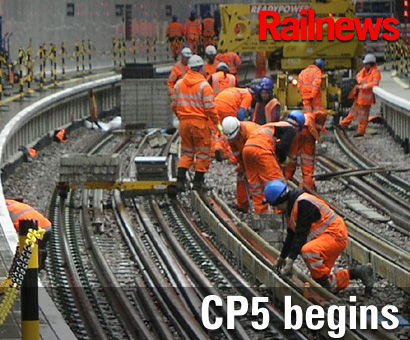NETWORK RAIL is poised to begin Control Period 5, which involves a budget of £38.4 billion and will run until the end of March 2019.
Plans for the coming five years involve £12 billion invested in capital projects, which include new lines and modernised stations, as well as more than 1,200km of electrification. By the end of the period, electric trains will be running on the Midland Main Line between London and Sheffield, and on the Great Western Main Line to Bristol and Swansea.
There will also be electric trains on a number of routes in the north of England.
Mark Carne, the new chief executive of Network Rail, said: “Millions of passengers and freight users will benefit enormously from the plans we set out today to wisely spend and invest £38 billion in transforming some of the busiest parts of our railway network.”
Improving passenger, public and workforce safety will also feature prominently, with plans to close a further 500 level crossings on top of the almost 800 closed since 2010, which Network Rail said would reduce risk by a further 25 per cent.
Mr Carne commented: “Passenger, public and workforce safety will be at the core of our plans. Good safety performance and good train and business performance go hand-in-hand and in both, we must strive for, and deliver, continuous improvement day by day.”
Transport secretary Patrick McLoughlin said: “A key part of this government's long term economic plan is investing in world class infrastructure. That is why we are putting record amounts of government funding into our railways over the next five years. That investment will generate growth, create jobs and boost business while delivering faster journeys, greater comfort and better punctuality.”
The people of Devon and Cornwall also heard some good news today as Network Rail confirmed that the Great Western Main Line will be reopened through Dawlish on 4 April. A new landslip involving the collapse of 20,000 tonnes of cliff face near Teignmouth on 4 March had threatened the planned reopening, but the slip was controlled and the danger of a new blockage on the line was averted.
Another landslip 11km north of Hastings at Whatlington in East Sussex has also been stabilised, which means that trains will be running again today between Hastings and Tonbridge.
In a further landmark event two new platforms will open today at London Bridge. Platforms 14 and 15 are the first to open in the new station which is being rebuilt for the Thameslink Programme. When completed, London Bridge will have six terminating platforms and nine through ones. Previously those figures were reversed, but converting three of the terminating platforms to through lines will mean that Thameslink trains will be able to call at London Bridge throughout the rush hours within a few years, instead of being diverted as they are now because of a lack of paths.
Mr Carne said: "Dawlish has shown us at our best when we work in a planned, disciplined and innovative way. Our aim is to emulate that approach and embed it in our organisation so that we are continuously improving the service for our customers.”
By 2019 the railway is expected to be carrying more people than at any time in its history if present growth continues. The industry's five-year plan will provide 170,000 extra seats for commuters in peak hours, shorten journeys and provide for hundreds more daily services between the cities of the north, see new fleets of electric trains and modernise or rebuild hundreds of stations including London Bridge, Manchester Victoria, Birmingham New Street and Glasgow Queen Street.
Mr Carne concluded: "Britain’s railways are a vital part of our national infrastructure. They connect homes and workplaces, businesses with markets, they create jobs, stimulate trade and support the growth of a balanced economy.
“We are good at delivering projects both great and small and at providing a safe and reliable railway but want to do even more for the people that rely on our railway network. This investment responds to the growth and demands being placed upon us by delivering bigger, better stations, more trains and seats, reopened railway lines and fewer level crossings. We all want an improving, safer, successful and better value railway for everyone, and that is what we will do."


